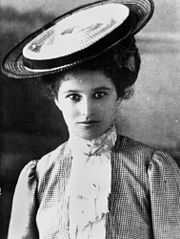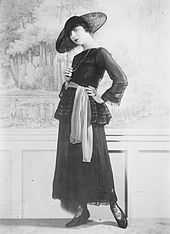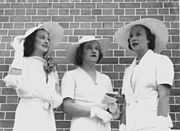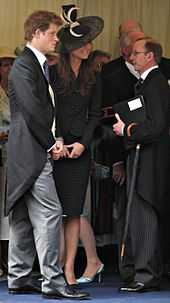Cartwheel hat

A cartwheel hat (also cart wheel hat) is a wide brimmed circular or saucer-shaped design. It may be made in a variety of materials, including straw or felt and usually has a low crown. It may be similar to the picture hat and halo-brimmed hat in shape.[1] Typically, it is worn at an angle to show off the curve of the brim, rather than being worn at the back of the head in the manner of a halo hat.
History

The cartwheel hat became popular in the years leading up to World War I. The Milwaukee Sentinel described the new fashion in 1914: "Do not be astounded if you notice a smartly gowned woman with a hat of huge proportions...The new large hats are broad brimmed and have low crowns, which are not discernible when the hat is worn, hence they resemble cartwheels tilted at a becoming angle".[2] These early versions might be covered in velvet, taffeta or silk; some included flower, fur or feather trims.[2]

1930s styles
The cartwheel hat appeared in films and fashion during the 1930s – an American newspaper described the latest Paris fashion for straight and curled-brim cartwheel designs in 1934. The correspondent described crowns so shallow that hats had to be secured with a rubber band above or below the hair, which must be "perfectly coiffed" as it was revealed by the hat.[3] In 1936, an Australian newspaper report about racegoers at Brisbane's Ascot racing meeting noted the abundance of: "wide-brimmed shady hats of the cartwheel type".[4] The following year, The Observer described: "cartwheel hats with exceedingly low crowns and brims which slope very slightly downwards", also noting that London milliner Aage Thaarup was showing versions for Ascot in straw and lemon-yellow felt.[5]
One of the most influential showcases of the potential of the style was the 1939 film Gone with the Wind, in which Vivien Leigh (Scarlett O'Hara) wore a huge cartwheel with green ribbons designed by celebrity milliner Mr. John.[6][7]
'New Look' trends
While a Hattie Carnegie cartwheel design appeared on the cover of American Vogue in 1938, the style is most associated with the period after World War II austerity and make-do-and-mend was over.[8] By 1945, new cartwheel styles were being offered with open crowns.[9]
Four years later, Rita Hayworth wore a variation on the cartwheel made of sheer material to match the pleated Jacques Fath dress for her 'low key' wedding to Aly Khan – an event that generated huge interest and replica designs of her outfit.[10][11] By spring 1950, the cartwheel hat was being tipped in Life alongside pleated dresses as the: "new silhouette". The hat designs featured were also by Mr. John.[12] A month later, Life noted: "The recent tendency to go bareheaded has been reversed simply because the new season's narrow silhouette looks better when balanced with a hat." The article singled out the cartwheel in a new "unseasonal" coral velvet.[13]

The cartwheel became particularly closely associated with New Look fashions. Dior's Y-line collection of autumn 1955 showcased cartwheel hats, paired with pearls, princess-line dresses and stoles.[14] While the size and shape of hats could be extreme, such designs were made not just for day but evening wear; the Victoria and Albert Museum archive includes a Christian Dior cocktail frock designed to be worn with matching tulle cartwheel hat.[15]
High-profile wearers of the style included Queen Elizabeth who wore a straw cartwheel shape on her tour of Australia the year after her coronation – although her hat was less extreme than some of the Dior models.[16]
Post 1950s revivals
The cartwheel hat has continued as a favourite showstopper for weddings and events – with designers such as Philip Somerville, Graham Smith and Frederick Fox including them in their millinery ranges.[17][18] There have also been notable revivals in high fashion; Christian Lacroix featured dramatic forward-angled designs in his 1987 autumn collection.[19] He also featured cartwheel shapes in neon orange and shocking pink in 2002.[20]
See also
References
- ↑ Chico, Beverly (2013). Hats and Headwear around the World: A Cultural Encyclopedia. Santa Barbara, California: ABC-CLIO LLC. pp. 211–12. ISBN 9781610690621. Retrieved 13 November 2014.
- ↑ 2.0 2.1 "The Cartwheel Hat". Milwaukee Sentinel. 27 September 1914. Retrieved 16 November 2014.
- ↑ Kerr, Adelaide (19 May 1934). "Cartwheel Crown, Shallow Brim Capture Stage". Spokane Daily Chronicle. Retrieved 16 November 2014.
- ↑ "Cartwheel hats combat sunshine: summer modes on Ascot lawns". The Courier-Mail Brisbane. 28 October 1936. Retrieved 18 November 2014.
- ↑ Settle, Alison (13 June 1937). "The hat picture drawn in sweeping lines". The Observer.
- ↑ Mulvagh, Jane (2 July 1993). "Obituary: John P. John". The Independent. Retrieved 18 November 2014.
- ↑ "Gone with the Wind, 1939". granger.com. Granger Historical Picture Archive. Retrieved 19 November 2014.
- ↑ Feder, Karan. "Star Milliners in American Fashion". museums.nevadaculture.org. Division of Museums and History Nevada. Retrieved 16 November 2014.
- ↑ "Summer Cartwheel Hat of Ruffled Horsehair Braid". Chicago Tribune. 24 May 1945. Retrieved 16 November 2014.
- ↑ Chambers, Rachel. "The story behind the styles". onthisdayinfashion.com. On This Day In Fashion. Retrieved 18 November 2014.
- ↑ "Rita Hayworth & Ali Khan". theredlist.com. The Red List. Retrieved 18 November 2014.
- ↑ "The new mobile pleat". Life. 13 March 1950. Retrieved 18 November 2014.
- ↑ "Spring Hats: this is the year for simple shapes". Life. 3 April 1950. Retrieved 18 November 2014.
- ↑ Franklin, Caryn (2012). Fashion: The Ultimate Book of Costume and Style. London: Dorling Kindersley. p. 319. ISBN 9781405398794. Retrieved 18 November 2014.
- ↑ "Cocktail dress, Dior". vam.ac.uk. Victoria and Albert Museum. Retrieved 16 November 2014.
- ↑ Ball, Sarah (31 May 2012). "Crowning Glory". Vanity Fair. Retrieved 19 November 2014.
- ↑ Mower, Sarah (21 May 1987). "Taking the plunge". The Guardian.
- ↑ Neustatter, Angela (27 April 1976). "Cover up jobs". The Guardian.
- ↑ Rumbold, Judy (19 October 1987). "Man who won the inch war". The Guardian.
- ↑ Cartner-Morley, Jess (10 July 2002). "Lagerfeld and Lacroix: simple silhouettes versus flamboyant feathers". The Guardian.
External links
- Cartwheel hat at University of North Texas archive
- New South Wales museum collection, black cartwheel design, c. 1950
- Getty image of 1946 cartwheel hat and evening gown
- British Pathé film showing cartwheel models, 1950
- Stephen Jones contemporary cartwheel hat in Ryerson Fashion Research Collection